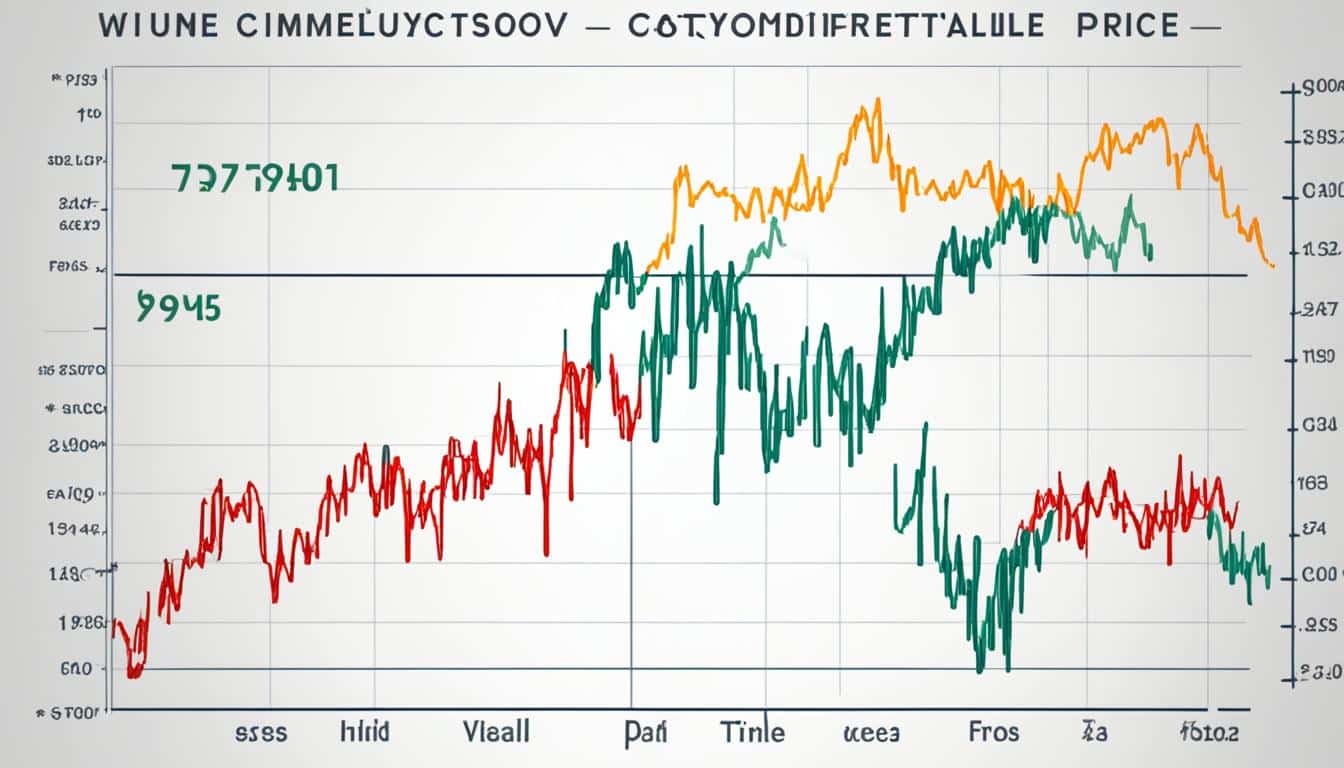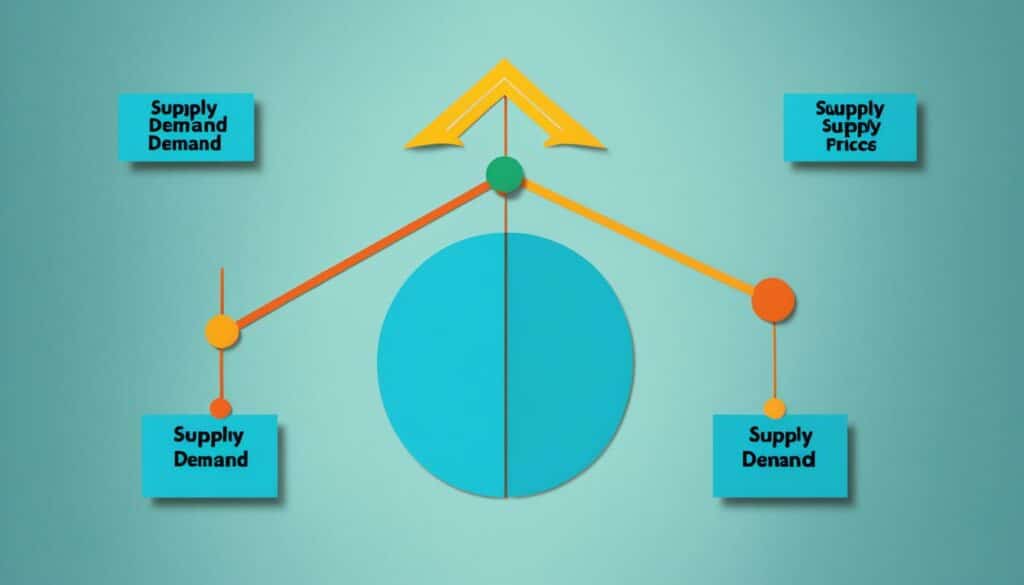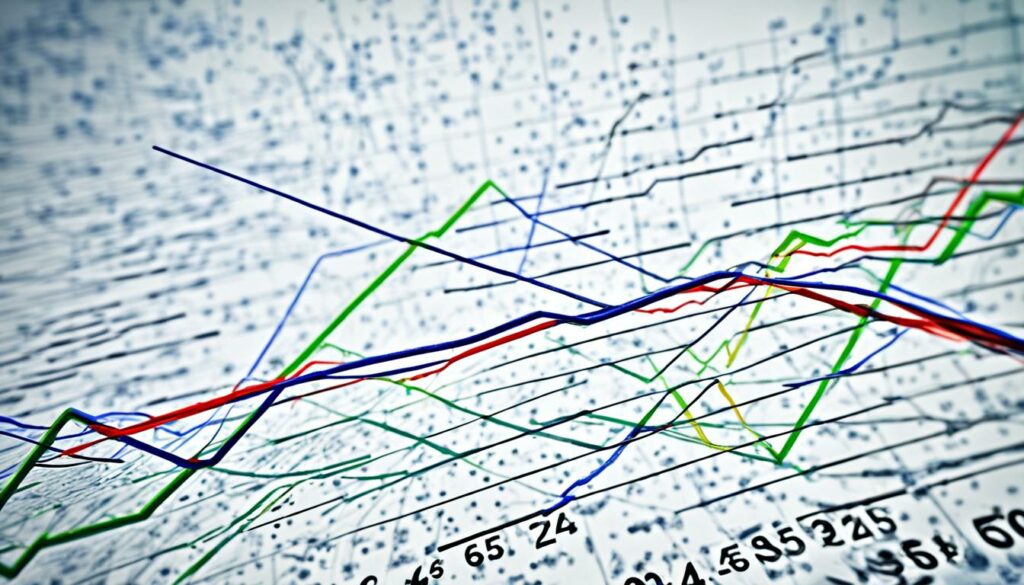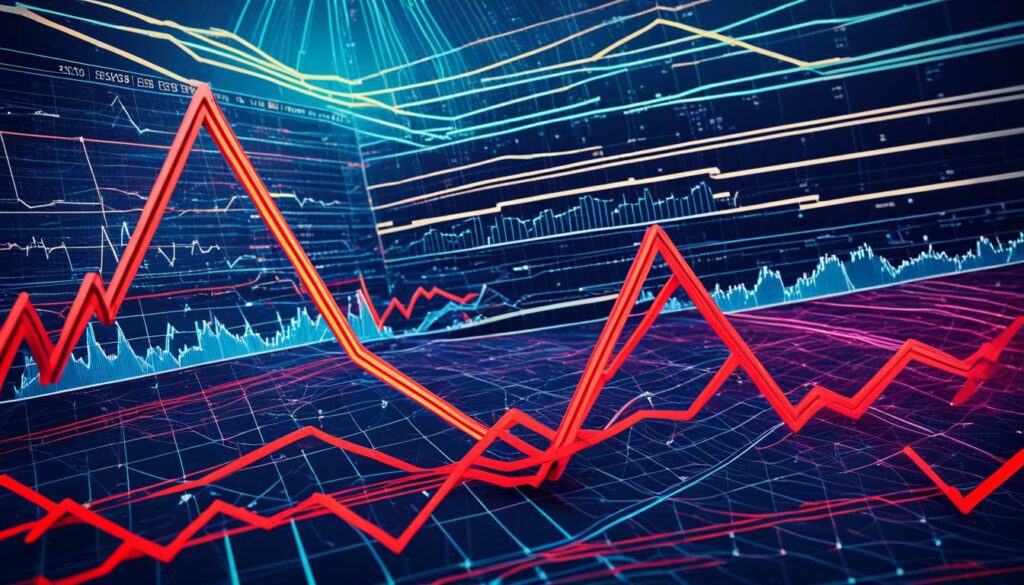Menu

John Anton has been at S&P Global since 1995. He’s a real expert on predicting commodity prices. His work for over 20 years has really changed how we see the market.
His main area is steel in the ferrous metals world. It’s super important for cars, building, energy, and the economy. He has a degree in Economics and a Law degree too.
I’ll explain the complex world of analyzing commodity prices. We’ll look at how steel, oil, and rice prices are set. And we’ll learn how experts like John use data to predict what will happen next. Come with me to understand more about this market.
Learning about commodity price analysis is key for economic planning and investment choices. It looks at price movements and data to guess what prices might do next.
In short, commodity price analysis guesses how prices will change. It looks at past trends, today’s data, and what might happen in the future. Using complex models, experts can forecast changes, something very significant for those dealing in trades and investments.
Understanding commodity prices well helps in making smart choices. It helps investors spot good chances and firms to use their money wisely. For example, companies that need a lot of raw materials can buy smarter by guessing the future prices.
Also, governments use this analysis to make economic plans and guess if prices might go up.
Many things impact prices, including:
To learn more about this topic, you can check out the Refresher Reading on commodity price analysis using member-only access. Or, get the full reading by downloading it.
Knowing about supply and demand is key in the world of commodities. Many things can change the way prices move. Studying how supply chains work and watching the demand worldwide, plus looking at big events, helps us make better market moves.

Products go through a lot before we can buy them. Supply chains can slow down or speed up prices. When making something gets more expensive, or there’s more competition, prices go up. But if things are made smoother in the supply chain, prices might stay the same or even go down. Knowing this helps us get ready for changes with the right tools.
What people want can change globally. Things like how much money people have, what they like, and how willing they are to switch products all matter. Some items sell less when prices rise a lot. But things that people always need sell just as much. Figuring out these trends helps predict price swings better. The balance point, where what’s made equals what’s wanted, is key for a steady market.
Big world events can suddenly change what’s wanted or made. Past crises caused a big fall in people wanting commodities, which dropped prices. These events show why we need to watch the world closely with the best commodity analysis tools. Using tools to predict trends and prices is crucial for smart buying and selling decisions during and after such events.
Looking at all these points helps us understand how supply and demand affect prices. Knowing this helps when looking at the market and making choices about where to put our money.
It’s key to know that commodities move in cycles when looking at historical commodity price analysis. By studying past prices, we learn how to risk less and make the most of new chances.
In 2021, the U.S. saw big jumps in what it imported. Items like food rose from $163,343 million to $193,771 million. This was an 18.6% increase.
Materials like minerals and metals went from $203,832 million to $261,472 million. That’s a 28.3% leap. Energy-related stuff increased by 74.1%, zooming from $125,911 million to $219,241 million.
The U.S. overall saw its imports go up from $537,666 million to $735,547 million. This 36.8% increase shows a big change. Contrast this with the rise in all other sectors, which was 16.6%.
| Commodity Sector | General Imports 2020 (Million $) | General Imports 2021 (Million $) | Percentage Change |
|---|---|---|---|
| Agricultural Products | 163,343 | 193,771 | 18.6% |
| Minerals and Metals | 203,832 | 261,472 | 28.3% |
| Energy-related Products | 125,911 | 219,241 | 74.1% |
| Forest Products | 44,580 | 61,064 | 37.0% |
| All Commodity Sectors Combined | 537,666 | 735,547 | 36.8% |
| All Other Sectors | 1,798,324 | 2,097,326 | 16.6% |
Exports also rose significantly. Food grew by 17.9%, materials by 32.3%, and energy items by 58.1%. The analysis shows big changes and growth, which affects trading and planning.
Energy costs were important. The price of oil imports went up to $60.41 in 2021 from $36.68 in 2020. Wheat export prices also increased notably, by 26.1%.
In 2021, the prices for energy, food, and materials went up a lot. This was driven by a 5.5% increase in the world economy, the most since the recession in about 80 years. So, knowing about the past helps in trading commodities effectively today.
Trading commodities needs a wide strategy. It includes fundamental, technical, and sentiment analysis. Using different tools, traders can predict prices well. They also make their trading plans better. This mix is excellent for dealing with the complex commodity markets.

Fundamental analysis checks big economic facts. These include inflation, currency strength, and GDP growth. They affect commodity prices, but not directly. Traders should also look at how supply meets demand, political happenings, and weather. For instance, oil prices can jump with unrest in oil-rich areas. Farm product prices can change a lot due to the weather.
“Commodity Contracts for Difference (CFDs) allow traders to speculate on commodity price movements without needing to own the underlying asset.”
Technical analysis looks at charts and past prices to spot chances to trade. It involves trend-following, breakout and range trading. Tools like RSI, EMA, and ADX are crucial. When the ADX is under 20, and Bollinger Bands match, it’s good for range trading.
| Technical Indicators | Strategy |
|---|---|
| RSI | Trend-following |
| EMA | Trend-following |
| Bollinger Bands | Range trading |
| ADX | Range trading |
Sentiment analysis looks at the market’s mood. It includes watching news, reports, and what’s talked about on social media. Traders use this to know how others feel about the market. It helps them adjust their plans. What people generally feel can hint at big price changes. So, it’s key in commodity trading.
Putting these together makes a trader really get the market. Fundamental analysis looks at wider economic trends. Technical analysis gives clear trading cues. Sentiment analysis tells you what the market feels like. Together, they are a strong method for guessing commodity prices well.
Accurate market data is the key to understanding commodity prices well. Commodity markets are very important for the world’s economy. They deal with raw materials like food, metal, and energy. Good market insights help traders a lot. They can predict and deal with commodity price trends better.
Commodity markets change a lot and can be risky. Many things affect them, such as the cost of living and events around the world. Farm products are also affected by the weather. Getting detailed and accurate market data is crucial. This is especially true in big markets like the Chicago Mercantile Exchange (CME) and the Intercontinental Exchange (ICE). Wrong or old information can lead to bad choices and lose a lot of money.
Metals can protect against rising living costs, so it’s important to have the right data about them. The balance sheet method shows a link between how much there is and the price. This is clear in the U.S. soybean market. Prices from 2003 to 2013 went up and down with how much there was. This data is key to predicting prices.
Weather plays a big part in how much food there is. By using good, accurate data, traders can protect themselves better. They can use things like futures and options to avoid losing money. Knowing the market well lets traders use smart tactics. These tactics involve using past data, like moving averages, to guess what prices might do.
Having the right data helps traders be better at what they do. It encourages them to learn, manage risks, and stay calm. With this data, traders can make smarter choices about buying and selling. They understand the market better and can handle changes well.
| Commodity Type | Influencing Factors | Price Impact |
|---|---|---|
| Agricultural Commodities | Seasonal Cycles, Weather Patterns | High Volatility |
| Metals | Inflation, CPI | Inflation Hedge |
| Energy | Geopolitical Events, Supply Chains | Price Volatility |
Price forecasting in commodity markets mixes maths and educated guesses. It uses many methods to guess prices right. We’ll look at the main ways to predict what prices might do.
Quantitative methods use maths and past data to guess what prices will be. For instance, the Long Short-Term Memory (LSTM) model is great at predicting prices. It cares about things like how much money is being made and inflation.
| Quantitative Models | Data Inputs | Strengths | Weaknesses |
|---|---|---|---|
| Fundamental Analysis | Supply and demand data, economic trends | Broad economic insight | Complex and time-consuming |
| Technical Analysis | Historical price patterns, market trends | Quick identification of market trends | May overlook underlying economic factors |
| Machine Learning Models | Diverse datasets, time-series data | Adaptive and self-improving | Complexity and heavy computational power |
| Stochastic Models | Non-Gaussian distribution, time-varying data | Better performance in volatile markets | Advanced statistical knowledge required |

Qualitative approaches use expert views and feelings to guess prices. They give a big picture view and can help spot big changes or chances. Talking to experts often reveals more than just looking at numbers.
Prices are often predicted with both numbers and opinions. Tools and software make this easier and faster now. Also, there are tools to imagine different market futures to plan better.
Fabio L. Mattos taught the AECN 436 course at Nebraska-Lincoln in Spring 2017. Students learned a lot about predicting market prices there.
The world of commodity analysis is always changing. The right tools can make your strategy much better. Today, you can find everything from software to data analytics that give real-time insights into markets.
Top companies now have advanced software solutions for better analysis. Vesper lets you dive deep into various commodities with a subscription that starts with a 14-day free trial. Bloomberg is also top-notch but might be too much for some because of all its data. It needs a subscription too.
| Software Solution | Key Features | Subscription Model |
|---|---|---|
| Vesper | Comprehensive data coverage, 14-day free trial | Subscription-based |
| Bloomberg | Real-time updates, extensive data | Subscription-based |
Data analytics platforms are changing how traders work with commodities. The USDA Economic Research Service focuses on U.S. agricultural data, which might not always be up-to-date. The World Bank has great worldwide insights but might be hard to use at first. Trading Economics is known for frequent global updates.
| Data Analytics Platform | Key Features | Challenges |
|---|---|---|
| USDA Economic Research Service | U.S.-centric agricultural data | Potential update lags |
| World Bank | Global market insights | Complex user interface |
| Trading Economics | High-frequency global updates | Data complexity |
Market simulation tools guess at price changes using past and current data. MarketView links different parts of a business, letting everyone use the same data for their work. These tools help make better decisions by letting you test out ideas first.
Choosing the best commodity analysis tools and platforms can really boost your market approach. They give you an edge and deep understanding of the market.
Recently, algorithms have greatly changed the way we forecast commodity prices. The markets for commodities are getting more complicated and volatile each day. So, we rely more and more on advanced computational methods. We’ll look at what kinds of algorithms are used, how they improve daily trading decisions, and how they make trading tasks automatic.

Forecasting commodity prices has come a long way. We started with basic models based on big economic factors and financial trends. Now we use advanced methods like time series and stochastic models. These days, many rely on tools from the world of artificial intelligence (AI), machine learning (ML), and deep learning (DL). For instance, the LSTM method is very effective. It beats older ML models like Artificial Neural Networks (ANNs). A specific example is the Bloomberg Livestock Subindex and Bloomberg Industrial Metals Subindex. They excel in predicting how other commodity indices will perform.
Algorithm’s ability to make better daily trading decisions is a big plus. They figure out the best times to get in and out of a trade. This makes trading more precise and efficient. Those working with AI should start with ML models. If they need more accuracy, they can then move on to DL models. Since 2002, the market for commodities has seen a big boom due to these algorithmic advances.
Algorithms are also key in making trading automatic. With the help of advanced AI, ML, and DL, they can run trading smoothly. This helps cut down on mistakes and boosts how effective we are. Because of lots of swings in commodity markets over the last twenty years, using algorithms to trade can bring advantages. This has made it clear that accurate predictions of price changes are crucial for dealing with the changing market conditions.
Understanding commodity price analysis is key for sectors that need raw materials. For instance, the agriculture sector has faced big changes. Corn prices fell over 55% from 2012, and soybeans dropped more than 40%. These shifts show why it’s important to make smart decisions when trading.
Forecasting well in commodity trading is crucial. It helps firms use the best strategies to make products and move them efficiently. They can also protect themselves from big price changes and handle money risks smartly. Knowing the right commodity prices is vital, especially for agriculture, mining, and energy markets.
The NCCC-134 project has brought over 30 years of useful research. Every year, it hosts meetings with around 40 to 80 attendees. These events have talks and presentations. Many of these works then get published, showing the project’s real-world impact on commodity price analysis.
Advances in technology are also changing the game. Better drilling methods and renewable energy are altering how the market works. The focus on sustainable products is a clear sign of these big changes in trading commodities.
Take crude oil as an example. Its prices have fallen around 48%, thanks to both supply and political pressures. Live cattle prices also saw a drop of about 33%, showing wider market trends. Such events highlight the need for solid analysis when trading commodities.
Big meetings by multi-state projects also add a lot to this field. They have regular meetings with speakers and research sessions. These events help spread new findings and their practical uses. The project also keeps records since 1981, which are great for looking at the past.
When traders and investors use strong analysis, they do better in complex markets. This helps them lessen risks and find the best chances. Whether it’s about oil prices or new energy trends, applying commodity price analysis is key to success in trading.
Energy markets greatly affect commodity prices. With a move towards sustainable energy, the way prices fluctuate demands attention. This dynamic influences how we analyse commodity prices, affecting economic plans and investment choices.
The shift to sustainable energy is reshaping commodities. A rising need for renewable tech, like wind turbines and solar panels, has upped costs. Aluminium, copper, and steel prices are soaring. Since 2020, PV-grade polysilicon costs have soared over four times. Steel prices have also jumped by 50%, undoing any past cost decreases due to tech improvements.

Supply chains’ instability affects prices too. For example, natural gas prices fell around 40% in early 2024, hitting European benchmarks hard. The oil industry also saw prices fluctuate between $70 and $90 per barrel. These changes impact the consumer price index significantly. Energy alone represents about 7% of this index.
Having the right energy market data is critical for commodity price analysis. Accurate data is important for forecasting and decision-making. With commodity price changes very low since late 2023, experts predict a 3% energy price fall in 2024, with a further drop of 4% in 2025.
So, grasping how energy markets and commodity prices are linked is key. It helps us make sense of the challenges in moving towards sustainable energy.
Steel prices can show us how the economy is deeply connected. This case study highlights how steel tariffs and market changes affect many industries and global trade. Studying these issues helps us see the big economic impact.
The outlook for steel demand is vital for many areas like cars and buildings. A small increase in steel prices caused a big drop in exports and market share. This shows how important it is to keep an eye on steel prices for the whole economy.
Industries needing lots of steel, such as making cars, building and energy, feel it when steel prices shift. Losses from steel tariffs caused exports to drop by billions per year. It also hurt the manufacturing sector. This is why it’s crucial to always keep a close watch on steel prices.
Knowing the up-to-date steel prices is key for these industries’ profits. Steel tariffs raised production costs and hurt many jobs from 2002 to 2009. The steel industry has also seen big changes with more use of scrap in the last 20 years. Good analysis can help businesses make better decisions and stay profitable despite price changes.
It is crucial to understand steel demand and its links to other sectors. A deep analysis of steel prices can lead to better choices and readiness for market changes.

The commodity markets are always changing and can be hard to understand. That’s why companies need strong advisory help. S&P Global Commodity Insights® offers unique advice. They help businesses know where commodity prices are going. This way, companies can make smart choices. They use special knowledge and big databases to do this.
Trading issues, like the US stopping coal in a big area, or high rice prices from Brazil and Mexico, mean companies need advice more than ever. With these problems, understanding where prices are heading is crucial. The right advice can make a big difference.
Companies such as APLUS Enerji and Atos Worldgrid are leaders in energy advisory. They make special plans for each energy business. Atos has a special system for handling energy trades and risks. This helps everyone in the energy market feel secure.
Other important groups, like AXCELERUS and Business Benefits, are key in global markets. They offer advice on how to manage risks and make money. They’re known worldwide for helping businesses succeed in tough markets.
For those in Commodity Trading and Risk Management (CTRM), CapSpire is a good choice. They tailor their services to what you need. Commoditas Partners and Commoditas Technology know a lot about trading and energy. They make sure your tech is up to the latest standards.
Experts in handling price risks, like CommodityRA, offer critical help. So do others, like Emerging Markets Consulting (EMC). They offer IT and advice for best trading practices. Their help can protect businesses and keep them strong.
EnergyScan and Enerim give deep data and clever solutions for the energy world. Enverus helps with key business advice on a useful online platform. Lastly, e·Opt invents new ways to solve problems with their tech.
ETRM Energy Consultancy & Risk Management, everis, and FINAXIUM are experts in their fields. They meet a variety of energy trading needs and make sure strategies are solid. They know the market inside and out.
To make operations smoother, firms like gassen-consulting “gc” and HAKOM have good advice and real-time data solutions. Huge names like IBM, Hitachi Energy, and KPMG lead the way in advice. They help with audits, tax, and more worldwide.
Groups like KYOS and Lacima are focused on trading and risk. They use maths and problem-solving to give companies an advantage. LEAD Consult tailors advice just for the energy and finance sectors. Their detailed solutions are a big help.
All these advisory options ensure businesses can handle commodity market changes, avoid risks, and aim for success. They offer deep knowledge and personal help. This way, they keep companies competitive and ready for whatever the market brings.
The way we look at commodity prices is quickly changing. This shift is due to new technologies and the market’s changes. Trends like artificial intelligence, big data, and efforts to reduce carbon emissions shape how we understand and price commodities. They improve our ability to analyse. They also help us choose investments that are good for the planet.
Artificial intelligence (AI) is changing how we predict commodity prices. It can look at lots of data and find patterns that we might not see. This means AI can quickly adjust to changes, like drops in energy prices. It gives traders and investors key information.
Big data analytics is making a big difference too. It uses huge amounts of data to help analysts make better decisions. For example, it recently showed big drops in natural gas prices in Europe and the U.S. Big data also helps us prepare for expected rises in metal prices next year.
Look at this table to see predicted changes in commodity prices:
| Commodity | 2024 Projection (% Change) | 2025 Projection (% Change) |
|---|---|---|
| Energy Prices | -3% | -4% |
| Brent Crude Oil | US$84/bbl | US$79/bbl |
| Natural Gas (Europe) | -35% | N/A |
| Natural Gas (U.S.) | -22% | N/A |
| Metal Prices | Unchanged | Steady Rise |
Decarbonisation and ESG factors are changing how markets operate. Investors care more about green and ethical practices. This affects how commodities are bought and sold. This change is seen in the move to renewable energy. And it pushes us to think more broadly about commodity pricing.
These trends make the future of commodity analysis exciting. They offer great prospects for those who can change and find new solutions.
In the world of trading, many big factors affect prices. This piece has looked closely at these factors. It has talked about how supply, demand, historical trends, and strategies matter a lot. Understanding these things helps traders and investors make smart choices that fit with their goals.
The World Bank says prices for goods may keep falling. In 2024, they might drop by about 4 percent. Energy items could be 5 percent cheaper, while food prices stay on a low. Metals, however, might go up again in 2025 after an early fall. This shows why it’s crucial to have good, up-to-date details for making beneficial trade plans.
Right now, more interest in electric cars and green energy projects is shaking up the market for key minerals. This reminds us how important it is to watch the future trends. We need to keep up with new ways of looking at the market. Doing so helps us understand the intricate world of buying and selling goods globally.
Commodity price analysis looks at changes in prices to predict future ones. It checks out economic signs, what it costs to make things, and how people feel about the market. This helps guess where prices might go.
Looking at commodity prices is key for the economy and for making smart investment choices. It helps companies figure out the best times to buy or sell. This way, they can manage what they hold and how they trade.
Many things can change commodity prices. These include the economy, how much making stuff costs, what people think of the market, and even the impact of global events. All of these factors work together to set the price.
Prices are heavily influenced by how much of something is available and how many people want it. If it’s hard to get or many want it, prices can jump. Global events and changing trends can also shake up the market.
Looking back at prices can show the usual ups and downs. By learning from the past, we can make better choices now. This helps to make wise moves today for the market of tomorrow.
To trade well, people use methods that look at the basics, the technical stuff, and what feelings might tell us. Combining these approaches helps to build strong trading plans.
Good and up-to-date information is crucial for making the right decisions. Wrong or old data can steer you wrong. It’s like making a path without a map; you might not end up where you want.
Forecasting prices uses a mix of numbers and expert opinions. Modern tools and smart thinking make predictions more reliable. This way, we can make better guesses about where the prices will go.
Tools made for looking at commodities help us see deeper and better. They sharpen our way of understanding and dealing with the market. This makes trading smarter and more effective.
Algorithms can figure out the best times to enter or leave a trade. They can even do it on their own. By being so precise, they can make trading more efficient and smarter.
In the real world, understanding commodity prices helps traders, investors, and those making the big decisions. It affects money, making things, and how countries trade with each other.
The way we use and get energy can change the costs of other things. Knowing about energy helps us understand more about the economy. It also points to how we look after our planet.
Steel affects big industries like cars, building, and energy. Knowing what’s up with steel and if it’s worth the cost helps these areas surviving changing economic times.
There are services that offer expert help and tailor-made advice. They make it easier to understand the market, lower risks, and increase chances of doing well in trading.
Today, we see artificial intelligence and big data helping out. People also focus more on being green and socially responsible. These new paths are changing how we make trading choices and manage risks.